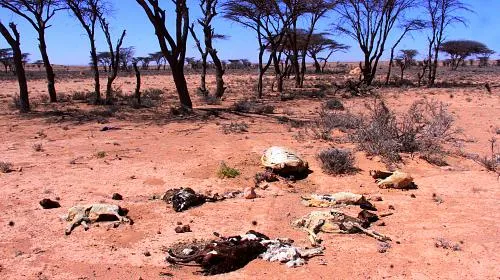NAIROBI (February 14, 2017) — Without funding to support millions of people in the Horn of Africa, the world will witness another severe food crisis and potentially a famine in parts of Somalia, warns the global humanitarian organization CARE.
“We are observing the same warning signs that preceded the famine in Somalia six years ago,” says Raheel Nazir Chaudhary, CARE’s Country Director in Somalia. “Consecutive droughts over the last two years, exacerbated by one of the strongest El Niño events ever recorded, have completely depleted people’s food supplies and killed their livestock.”
The roads and settlements in Sool, Sanaag and Bari regions of Somalia are littered with animal carcasses. Communities have lost half or more of their livestock. Almost all pastoralist households reported that they are reducing their daily meals. Prices for livestock – families’ main income – have plunged by 70-85 percent, while prices for water and food have skyrocketed.
“A threefold increase in water costs means it is out of reach for a vast majority of households. We are already seeing people spending half their income on water and many families are forced to migrate in search for food and pasture,” says Chaudhary.
According to CARE’s latest assessments in Somalia, families have to sell goats for $15. Before the drought, they could earn $70. In some areas, the price for a barrel of water has risen by 400 percent, to $10 from $2 before the drought.
“We have lost all our livestock,” said Rahma Ali, a 31-year-old woman from the Sool area in Somalia. “We have no other source of income. We can’t find or buy water. My children and I are at risk of exhaustion and starvation.”
More than 15 million people are currently affected by the drought in Ethiopia, Kenya and Somalia. Among them are nearly 680,000 pregnant women and lactating mothers. Malnutrition during pregnancy and the first two years of a child’s life can have a very negative lasting impact on the child’s future health and development.
“Women and girls are the most affected by droughts and food crises. As families are skipping meals and only eat once a day, women and girls eat last and the least,” warns Chaudhary. “In Somalia, women and girls are responsible for herding small livestock and collecting water. Yet as most water points dried up, they now have to walk on average 30 miles in search for water.”
The current drought caused by the La Niña phenomena and the strong El Niño of 2015/16 has impacted an area that suffered greatly during the 2011 Horn of Africa food crisis and famine in Somalia. While many aid organizations, governments and UN agencies have worked to bolster families’ capacities since 2011 to climate shocks, the severity of the current drought is destroying the gains made.
“The forecasts are bleak. If it won’t rain in the coming months, famine will become a possibility in Somalia. We need funding now to prevent families from tipping over the edge into severe hunger,” Chaudhary said.
Despite repeated early warnings in 2011, the response to that crisis was too slow, and more than 260,000 people died. “Today, we still have time to implement early response programs to help protect people’s assets and food stocks, prevent people from going hungry and prevent hundreds of thousands of children from suffering crippling malnutrition”, says Chaudhary. “We cannot wait until the TV cameras appear and start broadcasting starving children. The time to support is now.”
CARE Somalia has reached almost 259,000 people in Somaliland, Puntland and south central Somalia with clean water, cash transfer, relief supplies, nutrition support and protection of women and girls. CARE plans to reach another 350,000 Somalis in the next six months with crucial humanitarian aid. In Ethiopia, CARE has supported over one million drought affected people with water support, food, seeds and cash.
About CARE: Founded in 1945, CARE is a leading humanitarian organization fighting global poverty. CARE has more than six decades of experience helping people prepare for disasters, providing lifesaving assistance when a crisis hits, and helping communities recover after the emergency has passed. CARE places special focus on women and children, who are often disproportionately affected by disasters. To learn more, visit www.care.org.
Media contacts:
Nicole Harris, nharris@care.org, 404-735-0871

